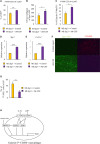MerTK Expression and ERK Activation Are Essential for the Functional Maturation of Osteopontin-Producing Reparative Macrophages After Myocardial Infarction
- PMID: 32865099
- PMCID: PMC7726992
- DOI: 10.1161/JAHA.120.017071
MerTK Expression and ERK Activation Are Essential for the Functional Maturation of Osteopontin-Producing Reparative Macrophages After Myocardial Infarction
Abstract
Background We previously reported that osteopontin plays an essential role in accelerating both reparative fibrosis and clearance of dead cells (efferocytosis) during tissue repair after myocardial infarction (MI) and galectin-3hiCD206+ macrophages is the main source of osteopontin in post-MI heart. Interleukin-10- STAT3 (signal transducer and activator of transcription 3)-galectin-3 axis is essential for Spp1 (encoding osteopontin) transcriptional activation in cardiac macrophages after MI. Here, we investigated the more detailed mechanism responsible for functional maturation of osteopontin-producing macrophages. Methods and Results In post-MI hearts, Spp1 transcriptional activation occurred almost exclusively in MerTK (Mer tyrosine kinase)+ galectin-3hi macrophages. The induction of MerTK on galectin-3hi macrophages is essential for their functional maturation including efferocytosis and Spp1 transcriptional activity. MerTK+galectin-3hi macrophages showed a strong activation of both STAT3 and ERK (extracellular signal-regulated kinase). STAT3 inhibition suppressed the differentiation of osteopontin-producing MerTK+galectin-3hi macrophages, however, STAT3 activation was insufficient at inducing Spp1 transcriptional activity. ERK inhibition suppressed Spp1 transcriptional activation without affecting MerTK or galectin-3 expression. Concomitant activation of ERK is required for transcriptional activation of Spp1. In Il-10 knockout enhanced green fluorescent protein-Spp1 knock-in mice subjected to MI, osteopontin-producing macrophages decreased but did not disappear entirely. Interleukin-10 and macrophage colony-stimulating factor synergistically activated STAT3 and ERK and promoted the differentiation of osteopontin-producing MerTK+galectin-3hi macrophages in bone marrow-derived macrophages. Coadministration of anti-interleukin-10 plus anti-macrophage colony-stimulating factor antibodies substantially reduced the number of osteopontin-producing macrophages by more than anti-interleukin-10 antibody alone in post-MI hearts. Conclusions Interleukin-10 and macrophage colony-stimulating factor act synergistically to activate STAT3 and ERK in cardiac macrophages, which in turn upregulate the expression of galectin-3 and MerTK, leading to the functional maturation of osteopontin-producing macrophages.
Keywords: MerTK; galectin‐3; macrophage; macrophage colony‐stimulating factor; myocardial infarction; osteopontin.
Conflict of interest statement
None.
Figures








References
-
- Horckmans M, Ring L, Duchene J, Santovito D, Schloss MJ, Drechsler M, Weber C, Soehnlein O, Steffens S. Neutrophils orchestrate post‐myocardial infarction healing by polarizing macrophages towards a reparative phenotype. Eur Heart J. 2017;187–197. - PubMed
-
- Wan E, Yeap XY, Dehn S, Terry R, Novak M, Zhang S, Iwata S, Han X, Homma S, Drosatos K, et al. Enhanced efferocytosis of apoptotic cardiomyocytes through myeloid‐epithelial‐reproductive tyrosine kinase links acute inflammation resolution to cardiac repair after infarction. Circ Res. 2013;1004–1012. - PMC - PubMed
Publication types
MeSH terms
Substances
LinkOut - more resources
Full Text Sources
Medical
Molecular Biology Databases
Research Materials
Miscellaneous

